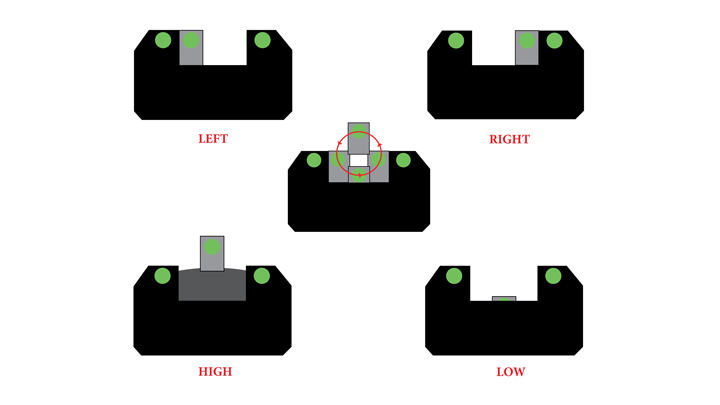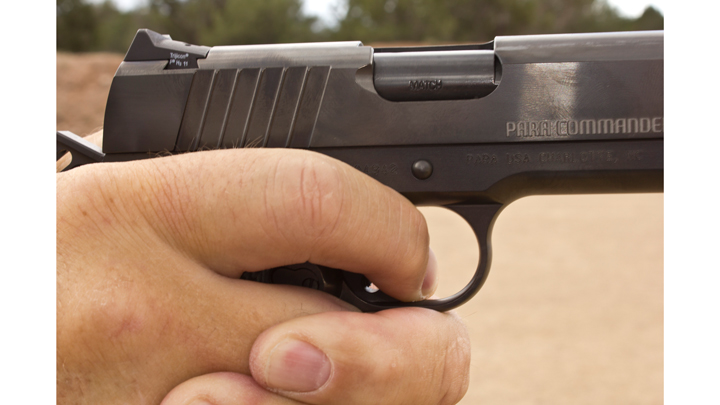
Secrets learned are nothing more than information the dedicated have uncovered with time. I'm going to give you the secret to shooting a handgun accurately. And I’m going to give it away in the very first paragraph of this article. Next to firearm safety, the single most important skill you must master with a handgun is the ability to operate the trigger—make the handgun fire—without disturbing the sight picture. That's it. The secret is out.
As simple as it sounds, this single task is the most difficult part of becoming proficient with a defensive handgun. It is also the foundation which must be laid before other defensive handgun skills can be acquired. Anything you build on a foundation that is not up to par is doomed from the start. At some point, you will add something to this less than ideal foundation which will cause it to collapse. It might be stress, unique positions, low light, fear, or a host of other circumstances through which you must perform. No matter, if your foundation has not been constructed properly, trouble is coming your way.
The secret is not really a secret at all; the successful operation of any individual weapon system is dependent on this same premise. In order to hit the target, eyes and hands—tethered by the mind—must work together.
Sight Alignment
Explaining the proper alignment of handgun sights used to be easy because there was really only one type of sight. Today we have a variety of sight types to include electronic sights like lasers and reflex sights. Regardless of the type of sight, the principle is the same; the sight must be pointing at the desired point of impact. With lasers or reflex sights this is easy to explain; the dot goes on the target. With more conventional notch rear/post front sights the explanation becomes a bit more complex.
With traditional sights, not only must the front sight be positioned on the target at the desired point of impact, the front sight must also be properly aligned with the rear sight. Though this alignment will slightly vary depending on the sight type, for the most part it can be described as having the front sight centered—left to right—in in the rear sight notch, with the top of the front sight even with the top of the rear sight.

What you will learn with practice is how much variance in the left and right and up and down alignment will allow you to still achieve a center hit. For example, out to a distance of about 5 yards, as long as the front sight is somewhere between the left and right sides of the rear notch, and as long as the top of the front sight is on the desired point of aim and somewhere between the top and bottom of the rear notch, your bullets should land within about a 5-inch to 7-inch area. This is well within the center-mass of a human adversary and suitable for defensive purposes.
Granted, if you want pinpoint accuracy you will need perfect sight alignment. However, establishing perfect sight alignment takes time and in a defensive encounter time is a commodity that is not in abundance.
Trigger Control
The triggers on defensive handguns run the gamut from extraordinarily good to simply atrocious. Pull weights can vary from as low as 2 pounds on well-tuned 1911 style handguns to more than 10 pounds on double-action revolvers. Additionally, triggers can feel like they drag or even have a hitch. This all makes pulling the trigger without moving the gun/sights very difficult.
There is only one way to get better at pulling a trigger and that is to pull a trigger a lot of times. It’s one of the reasons dry practice is commonly talked about, and frequently used by those who shoot very well. Surprisingly, even triggers that seem dreadful can be mastered, with either practice or in worst cases, by a gunsmith.

One key to pulling a trigger without disturbing the sights is to isolate the movement of your trigger finger from the rest of your hand. You need to be able to press the trigger with your index finger without tightening your grip, twisting your wrist, or anticipating the recoil and flinching. This is obviously a slow process that starts with single shots and then progresses from slow to fast multiple shot strings. The thing is, regardless of how fast you pull the trigger the basic principle applies; press the trigger while inducing the minimum amount of movement to the handgun as possible.
After lots of dry practice and lots of live-fire practice, your mind will begin to establish a memory of what your eyes should see and how your finger should press. Ultimately, it will begin to seem like your eye pulls the trigger. When that happens, you will have mastered the secret. However, like was mentioned before, other influencers like stress, unique positions, low light, fear, or a host of other circumstances impact your mind’s ability to effectively communicate what your eye is seeing to your finger.
Sight alignment and trigger control are the foundation of accurate shooting. However, it is a foundation that must be continually maintained and practiced. The secret to accurate shooting is really no mystery at all. Mastering that secret is not a mystery either; it’s called practice.




































